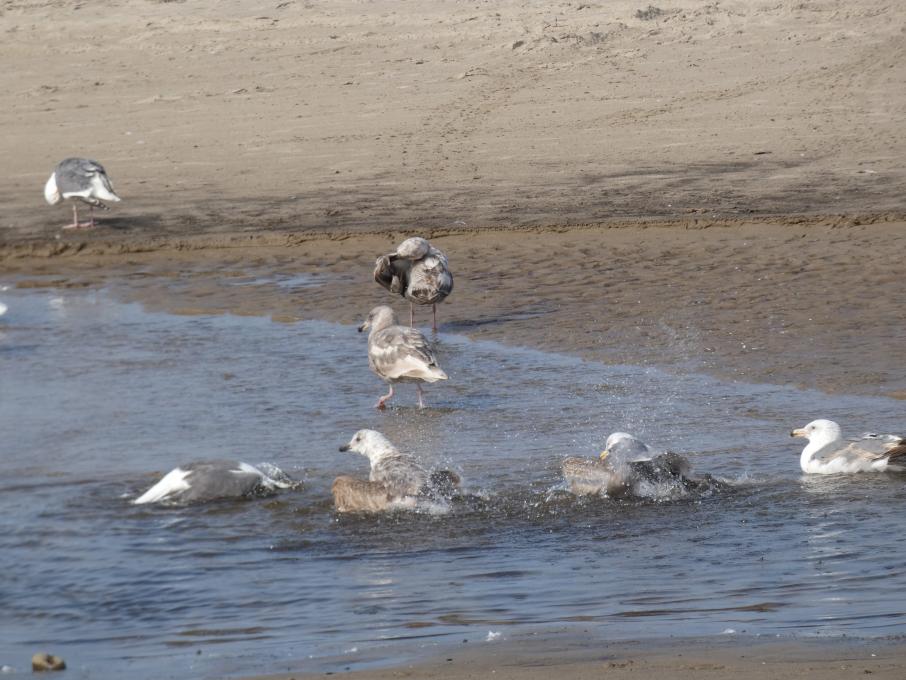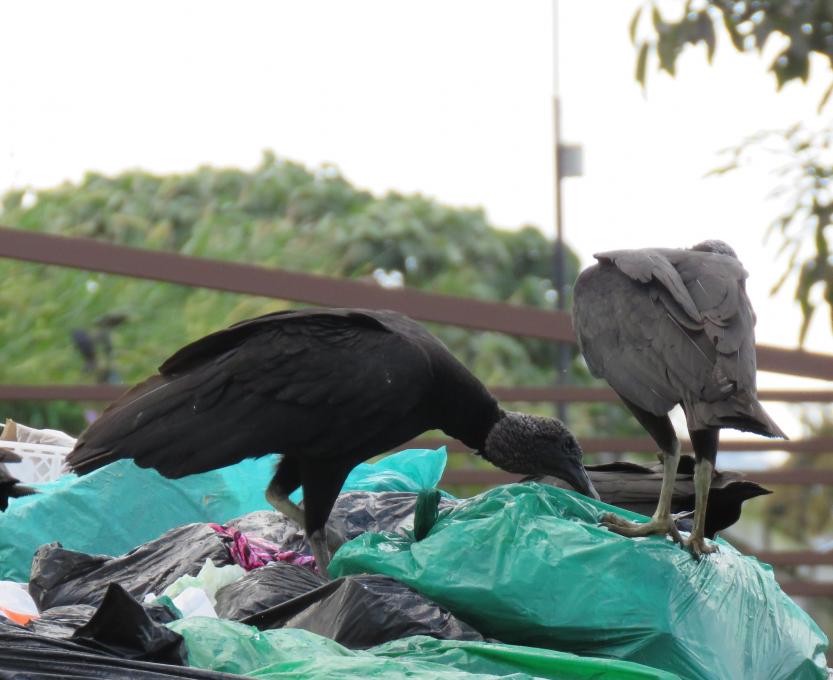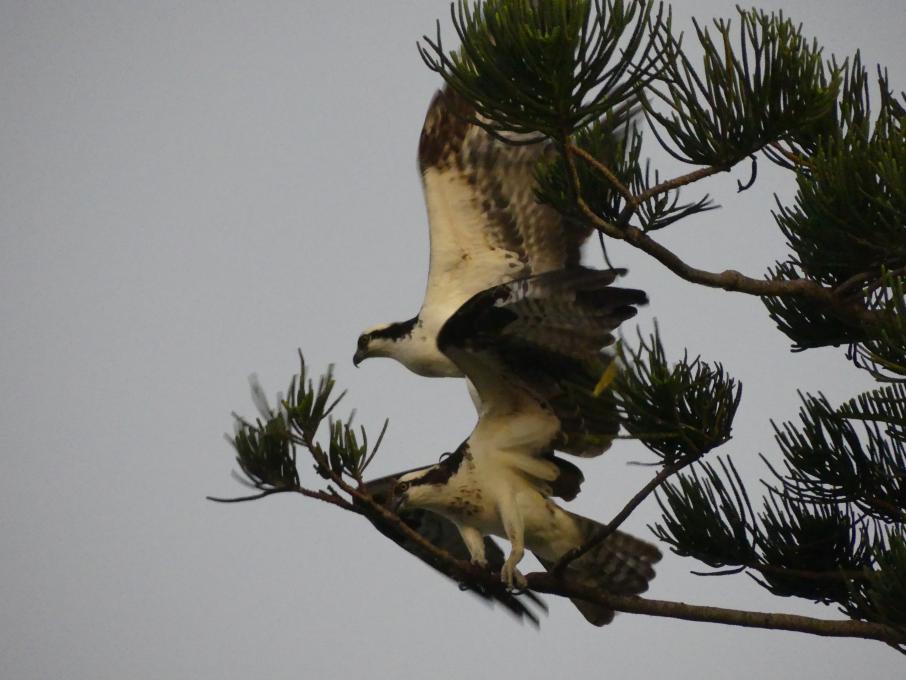The Cornell Lab Bird Academy › Discussion Groups › Joy of Birdwatching › Activities: Noticing Behaviors
-
 I am visiting the Oregon Coast and observed some Western Gulls (at least, I think they are Western Gulls) bathing. This is a fresh water stream and they are bathing where the stream meets the beach and the ocean. I counted 114 gulls there. It was like they were having a party. They really seemed to be enjoying themselves.
I am visiting the Oregon Coast and observed some Western Gulls (at least, I think they are Western Gulls) bathing. This is a fresh water stream and they are bathing where the stream meets the beach and the ocean. I counted 114 gulls there. It was like they were having a party. They really seemed to be enjoying themselves. -
All the bird cams right now are fun to watch with all the fluffy chicks! On the feeder cam I saw a starling feeding her 3 chicks.
-
Saw Red tailed hawk, American kestrels and Savannah Ospreys in the bird cam. While the Red tailed hawk was on guard of his offspring, the osprey couple were cleaning themselves. Saw a bunch of kestrel chics huddled together without either of their parents. In the feeder cam saw American Robins, Black Birds and Red winged black birds. While Red winged black birds spent considerable time picking up grains, the other two species were fast movers.
-
 Before the garbage truck picks up the garbage bags, this area becomes a feeder for black vultures
Before the garbage truck picks up the garbage bags, this area becomes a feeder for black vultures -
Avtivity 2. The black bellied Whistler ducks are so fun to watch at the feeder. They land away from the feeder and will watch for a few minutes. Then they slowly walk up, as if they don’t want to interrupt. Once there, one will be on the lookout while the others feed. They socialize well with all birds and ducks there.
-
Activity 2: I find Black Capped Chickadees stay for the shortest time then any other bird at my feeders, and they only take one seed at a time. On the other hand, we have American Goldfinches which stay for the longest time at my feeders.
-
Techniques for eating: It has been interesting to observe how different birds process the seed at my feeders. Tufted titmice, chickadees, and blue jays hold the seed between their feet and pound the shell with their beaks to get at the “meat” inside. While goldfinches, purple finches and grosbeaks can just crack the seed in their beaks and swallow the edible part.
-
We love bird cams! Since we do not yet have our own bird feeder, these cams are a fun way to observe different kinds of birds up close and personal. We have been watching a hummingbird nest cam for a couple of weeks. Those two babies are growing fast and they hardly fit in the nest anymore. It’s fascinating to watch the mother return to feed them, thrusting her beak so far down her baby’s throat it appears she might poke them all the way through! We also watch the Cornell Lab Feeder Cam every day. The blue jays will grab a peanut and fly away with it. The woodpecker hammers at the vertical trays. And then there are the squirrels...
-
Getting better at some call identification: Today I made out cardinal, red bellied woodpecker, tufted titmouse, Carolina wren, European starling, crow, Eastern towhee.
-
I went to a lake - there were a lot of Canada Geese. Watched them for a while, mostly foraging on the grass, but one interesting behavior was that, while the others were eating or resting, there would be a couple that stood at attention - like they were standing guard. I also watched a pair of buffleheads on the lake, diving for food. It was just a pair (male and female), although there were others in a larger group with geese and mallards further down the lake. I think I may have a new favorite bird - they were fun to watch.
-
Activity 2 was perfect for me this week because I just got several bird feeders from my local Buy Nothing group. I have enjoyed watching how different birds approach the seeds. A pair of tufted titmouses (or is it tufted titmice?) take turns at the feeder and take one seed at a time. The downy woodpecker takes only the sunflower seeds, while the Carolina chickadee only takes the millet. The house sparrows will sit and eat and eat until another bird comes to their perch. Some are bothered by the nearby squirrels looking out for anything that drops to the ground, while others are unfazed. It really is fascinating! I also tried Activity 3 - sort of. As of now, I can confidently identify the blue jay and the cardinal. I am trying to learn other calls.
-
1. Red-winged blackbirds. Eat heartily and then fly away. Come back again. One picks up a big piece and holds it for a while and then eats it. Birds grab food and fly away before eating it. Present in a small flock of them. (March 16, 2021 bird cam at Cornell) 2. Viewed Panama Fruit Feeder Cam for a few minutes. Observed a gorgeous Toucan pick up bits of banana at time. Puts head back as it swallows pieces. Pulls back peel and then picks out bits of fruit. Bill is a beautiful rainbow color.
-
1. The Dark Eyed Juncos operate as a flock (apart from one brave little guy who comes to the feeder) I see them in the trees or on the grass, if one startles they all do. 2. We are lucky to have three different species of woodpecker on our feeder. The Downy and Hairy Woodpeckers will stay on the suet feeder for several minutes, taking beak full after beak full of food, the Red Headed Woodpecker however only feeds from the peanut feeder, and never stays more than a few seconds. Of the other birds, I always notice how incredibly speedy the Tufted Titmouse's visits are, compared to the sparrows.
-
1. Song sparrow flits around on ground and visits the ground below the feeder. Seems to go to the feeder when there are very few other birds present. Also spends time holding to branch, singing. 2. Song sparrow eats on the ground below and doesn’t stay too long. House finches sit on feeder and on the ground. Seem to stay longer, usually in a group and will fly up to tree then right back for more food. 3. Song sparrows sings very often. Northern cardinal and house finches can also be heard.
-
Watching a couple of feeders outside my windows has certainly taught me much. A smaller finch feeder brings lots of chick-a-dees and red breasted nut-hatches. A suet feeder brings these same birds, plus, hairy and downy wood peckers, white breasted nut hatches and blue jays. I even saw a brown creeper today. A bigger open feeder at the back of my house holds mostly sunflower seeds which the same birds (except the wood peckers) visit. Sometimes mourning doves come there as well. They all seem to take turns. Blue jays first, then comes the little red squirrel for while. When he leaves the smaller birds have their turn. The blue jays hold the sunflower seeds in their toes, whack it open with their beak and then eat, all the while sitting on the edge of the feeder. The smaller birds grab a seed and sit in a nearby tree to eat.
-
I have learned A LOT from watching my feeders, too. I am up to 12 lifer birds on Merlin - how about you?
-
-
There are ospreys nesting near my grandmother's house in Melbourne Beach, FL, and I caught this photo of a pair in a tree nearby--turned out to be a lucky shot of a mating attempt!

-
Activity 1: I watched the Cornell Bird Feeder Cam and saw a number of birds that frequent my feeders in southeastern Michigan. The chickadees and titmice grabbed something to eat and flew away quickly. I read that the chickadees like to store food, which is one of the reasons they don't stay to eat. The white-breasted nuthatch spent a few minutes eating and then flew away. The downy woodpecker pecked steadily at the suet for several minutes and then flew away. The starlings stayed a little longer, eating seeds constantly. The Mourning Dove stayed the longest and ate very steadily. The dove's behavior was very docile and he/she shared the space easily with the smaller birds - who all seemed unconcerned about the presence of the larger bird. I read that doves fill their 'crops' and then fly away to digest while resting. Activity 2: I watched the Ontario Bird Feeder Cam, where I saw birds that frequent my feeder in southeastern Michigan, as well. Once again, the Chickadee was remarkably fast at grabbing food and leaving. The red-breasted Nuthatch spent a little more time but also left relatively quickly. Activity 3: I listened to the dawn chorus in a forest in central New York. The photo was quite lovely - I think it was of the beaver pond. The recording of the dawn chorus was really beautiful but I did not recognize any bird songs.
-
We are fortunate enough to live in an area with a lot of open spaces. There are several red tailed hawks that frequent the area. We also have a large number of crows and mockingbirds. As such, “mobbing” is observed quite often.
-
I notice a number of comments about Blue Jays. I have had a lot of fun watching a group of about five come to a flat feeder for peanuts in the shell at my feeding station. One, who appears to be a dominant male, provides the most interesting behavioural traits. (I am assuming this bird is male so I'll call it 'he'). He appears to the feeder first and calls out to the others who only help themselves once he has picked through the offerings which are only one handful a day. He fussily chooses one which he gulps down his throat then takes a second peanut crosswise in his beak before flying off. The other jays can then take their turns but none have mastered the art of getting two peanuts at a time!
-
Activity 1: A few days ago I observed a Canada Goose doing "summersaults" and found it quite intriguing and amusing. I've looked up the behaviour and it seems it has been observed in many places, always surprising the birders who witness it. While not seen often, it doesn't seem to be as uncommon as I first thought, although nothing I read seemed to know why the birds were doing it. Perhaps bathing, stretching and exercising all at once! Activity 2: I enjoyed looked at all the bird cams. It is stunning the amount of knowledge being gained and shared about birds (and probably other things too) with the advent of the internet and computers. It leaves me totally awed! At the fruit camera in Panama, some birds did a quick peck at the fruit while others stayed and ripped and tore at it. Others flew in, took a quick peck and were off again. Activity 3: It's a nasty raining day here in Vancouver and all I can hear outside are the crows, and the occasional Anna's hummingbird chirp.
-
Activity 1: I have been actively participating in the eBird data collection for about a month and have had a chance to observe the birds at my feeders. Of particular interest is the behavior of the woodpeckers. I have three Downy woodpeackers, though rarely see all three at the feeder. I believe that they are a pair and a single or a pair and an offspring from this year, that is now on it's own. Where the paid seems to be around the feeder, the third will be nearby but will not venture in until the other two have fed and moved off. In my Red Bellied woodpeckers, I have two, I think a pair. However, one will often hide behind the trunk of the tree until the other moves off before moving to the feeder. I am not yet sure which is female and which a male. Activity 2: Dark-eyed juncos primarily feed on the ground. While Black-capped chickadees feed on the suet cakes, the general feeder, and on the ground. There does not seem to be rhyme or reason as to why, though it may be because of the the birds at the general feeder. All of the woodpeckers prefer the suet feeders. Tufted titmouse I have seen take the larger seeds with shells and move away to crack them. Activity 3: I listened to several recorded sessions and could identify the calls of Blue jay, irritation chatter of a Black-capped chickadee, the sound of a Mourning dove flying away, and the calls of Grackles who are in a group feeding.
-
I used the Ontario Feeder Cam and looked at the footage from 1-19-21, which included a group of Common Redpolls feeding on a flat feeder. Most of the birds ate and were neither aggressive, nor submissive. There were two aggressive birds that seemed to shoo at least two other birds from the portion of the feeder occupied by the aggressors. The more timid Redpolls simply moved to another part of the feeder; they were not completely run off. The aggression probably related to rank within the Redpoll group. Something spooked all of the Redpolls, as they all flew away at once, with the exception of one bird, which eventually left. I couldn’t tell what startled them.
-
Bluejays have been busy at my feeder. They make loud calls in the trees before they approach the feeder. They grab peanuts, which they take away to eat. They don't remain long at the feeder, but do like to sort through the seed to find the sunflower seeds. I enjoy their calls and turn to the feeder to watch these fellows. The red-bellied woodpecker also comes every day, to enjoy bird seed. He hangs from the bottom of the feeder, eating for several minutes before leaving to cling to a near-by tree trunk. I have heard his persistent drum on the tree but I will pay closer attention to identify his call which I discovered on the Merlin bird ap
-
I had no idea until taking this course that the loud call of the blue jay is how they keep track of each other. I always thought it was more menacing, since all the other birds fly away from the feeders. I guess the jays are calling to one another, and since they are some of the largest birds in my area, the others get out of the way.
-
-
Listening to the birds in our backyard we can usually hear the chickadee's distinctive song as well as the northern cardinal's call. The blue jay announces itself before swooping in, and the downy woodpecker seems to have a warning call when we disturb it by passing too close to the feeder. There are some pre-dawn songs, but I don't know which birds are up singing that early. This morning a small flock of geese passed overhead. It sounded like Canada geese, but when they came into view they seemed to be a much lighter color. Will check my guide to find some suspects.
-
The white-breasted nuthatch that visits daily has a definite preference for our peanut feeder. It pecks away until it gets a peanut in its beak and then immediately leaves the feeder. This behavior contrasts with the tufted titmouse that perches on top of a seed cake and only seems to leave when challenged by a larger bird.
Read More:
 I am visiting the Oregon Coast and observed some Western Gulls (at least, I think they are Western Gulls) bathing. This is a fresh water stream and they are bathing where the stream meets the beach and the ocean. I counted 114 gulls there. It was like they were having a party. They really seemed to be enjoying themselves.
I am visiting the Oregon Coast and observed some Western Gulls (at least, I think they are Western Gulls) bathing. This is a fresh water stream and they are bathing where the stream meets the beach and the ocean. I counted 114 gulls there. It was like they were having a party. They really seemed to be enjoying themselves.  Before the garbage truck picks up the garbage bags, this area becomes a feeder for black vultures
Before the garbage truck picks up the garbage bags, this area becomes a feeder for black vultures 